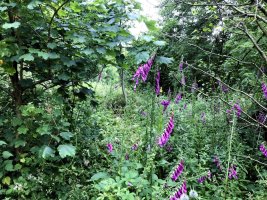The main thing, I think, is to remember that the fish evolved right alongside the beavers. In the US or UK, the story is the same.
Some BDA's will be really solid and wide because that's what the people who installed them decided was needed for that particular spot and the goals they were trying to reach.
In Australia, they do something similar with what they call "leaky weirs". They don't have beavers in that part of the world, but the leaky weirs are basically a BDA that allows water through at a slower pace so erosion is limited.
Everything is site-dependent. As you can see in this image, they needed cross-water access, so they lowered the road into the water rather keep it above. The 2nd weir upstream prevents the road from being washed out while also making a pond of sorts where marsh plants and baby fish can grow.
Deeply incised channels are bad for everyone, and most streams are now incised to one degree or another.
Here we can see another Australian "leaky weir" being installed across a dry gulch. There's no way for the water to spread out into the flood plain after the valley has been cut so deep, so the first step is to just stop the cutting.
Here's a good picture that shows how much the stream bed has risen behind the BDA. That's a solid foot or more of sediment captured, and over a huge area. That's all nutrient-rich soil that isn't simply being washed down to the ocean.
What I worry about is that people aren't using the lessons learned from the beavers.
Even though Australia never had beavers, they can still look to them for solutions. Beavers are the Grandmasters of water management, and their dams are proven to work for everything we could want in a dam. The further away we get from beaver dam design, like the leaky weirs you see above, the less effective and more costly the system will be.
In the US, our first BDA's were beautiful basket-weave structures anyone would be proud to have in their back garden.
We found that not only were these beautiful things harder to make, requiring nice saplings and heavy posts pounded in, but they also blew out easier in the Autumn and Winter when the rains came.
In short, we weren't really paying attention to what the beavers were showing us.
Notice how the BDA doesn't actually look like a beaver dam? Turns out, there's a reason why beavers build their dams like they do.
Looking at the genuine beaver dam above, we can see that it's really wide at the base and tapers out as it goes up. We also see a bunch of vertical sticks that are in-line with the flow of the water.
Now, as you might have surmised, the wider base makes for a stronger structure, but what surprised everyone was how those loosely-woven vertical sticks not only reinforced the dam like the buttresses on a Great Cathedral... but also served to break up the water that was passing through the dam. No dams are watertight. Having those vertical sticks there meant that any water coming through, especially over the top during a heavy rain, would be slowed down and broken up so that it couldn't scour the stream bed at the base of the dam and undermine it.
In short, that one little observation made a world of difference.
You'll see a lot of people piling big rocks on the downstream side of their leaky weirs because they know scouring is going to happen. That costs a lot of money and even more labor, and there's no need for it at all - as the beavers have shown us.
To be fair, we do have to do things a little different since we're trying to maximize the strength while minimizing our need to go out every year to repair them. Overbuilding isn't necessarily a bad thing if you have the time and money to do it. Trying to undo centuries of problems in a short timespan is perfectly reasonable, imo, since we do have the tools to build BDA's to a level that real beavers couldn't.
That doesn't mean we should ignore the little things they have to teach us, though.
If the flow of water is small enough, like with a tiny mountain tributary, there's no reason to pound posts. Beavers make dams with naught more than twigs and mud, so you can, too.
The key is in understanding the design.
Everything in the dam is small enough that a 100# beaver can move it by himself.
That means you can do it, too.
And just to show you how it's done.....
That's a picture of a genuine beaver dam; one of the very first built in Exmoor in some 400 years. The beavers were re-introduced to the area and they built their main dam a few dozen yards to the side. When the water backed up, it found a new path downhill and the beavers weren't having any of that nonsense.
Sure, the water's still flowing, but it's also ponding. We want the water to flow -- just slowed down and spread out. The beavers prevent deep gullies and raging torrents.
BDA's don't have to be big to make a big difference.
Here we see a crew of gents taking a break after making two BDA's that are just high enough that they'll help spread the flow out onto the flood plain when the rains come. And until then, they are slowing the water down so it can soak into the ground, recharging the water table. The scrub brush on the banks will slowly be drowned out as the water soaks in, making way for willow, cottonwood and aspen... and the beavers that eat them!




